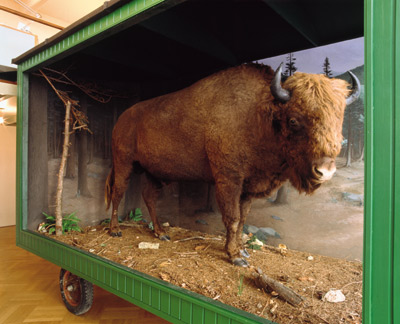Homo Cyklopicus
oktober 15th, 2006Admiral and Minister Pedro of the selfproclaimed freestate Ladonia has made an amazing discovery during his excavations. He has found a cranium which, no doubt, belongs to the hitherto unknown Homo Cyklopicus.
The scientists are developing two theories. King Ladon can have been Cyklops. It is also possible that cyclops lived in Ladonia long before and that Ulysseus during his travels visited Ladonia.
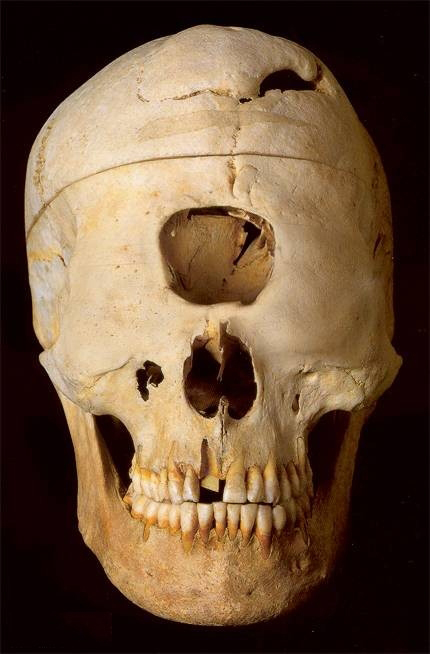
Admiral Pedro’s sensational discovery the Ladonian Cyklops.
Ladonia is a micronation, proclaimed in 1996 as the result of a years-long court battle between artist Lars Vilks and local authorities over two sculptures, ”Nimis” (Latin – ”too much”) and Arx (Latin – ”fortress”). These two colossal sculptures are erected without permit on a remote part of a nature reserve on Kullabergs northeast stony shores of southern Sweden. The battle about Arx and Nimis has rolled through the court system of Sweden during 20 years and has gone through the District Court and the Court of Civil and Criminal Appeal.
Ladonia is not recognized by any other accredited state, and acknowledging international law, there is no legal basis for calling it a state.
Ladonia acquires a colony in Norway (Telemark) acclaimed in 1997 on May 17th (National Day in Norway). An embassy was built in Falkenberg where the first official state visit also takes place.
San Fernando Galaxy
juni 19th, 2006Piero Golia
San Fernando Galaxy, 2006
photo 30×40 inches
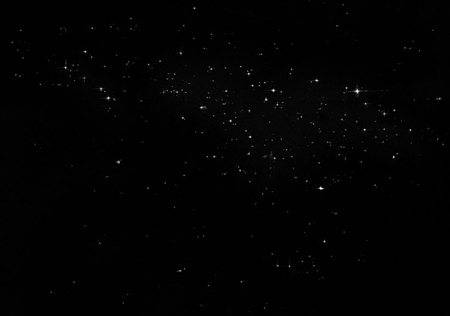
Night vision of San Fernando Valley, California, USA
‘America is nowhere so perfectly as in Los Angeles’ ubiquitous acres. One gets the impression that people came to Los Angeles in order to divorce themselves from the past, here to live or try to live in the rootless world of an adult child. One knows that if the cities of the world were destroyed by a new war, the architecture of the rebuilding would create a landscape which looked, subject to specification of climate, exactly and entirely like the San Fernando Valley’.
(Norman Mailer, from Superman comes to the supermarket, 1963)
EUTOPIA
juni 17th, 2006Europe is facing it’s most difficult challenge: how to create a united Europe? After the referenda on the new European Constitutional Law and the following disappointment about the French and Dutch NO, Europe is further away from unification than ever. But as a result inertia about Europa was replaced by genuine interest. What does it mean to be European? What do we represent? How much personal identity do we want to hand over to become a unity? The project is about the European Union as a whole and wants to raise questions about Europe in the past, the present and the future. Is Europe a new country with new borders or a concept for freedom and equality?
Maarten Vanden Eynde
Europe2006, 2006
Spun-poly silkscreen (155 gr/m2 polyester cloth), 100 x 150 cm
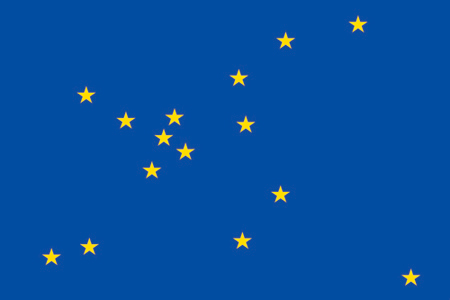
On the 9th of May, the official Europe Day, the new flag was presented throughout the whole European Union.
Participating Cultural institutions include:
The Vienna Künstlerhaus and State of Sabotage in Austria, The Latvian National Museum of Art and Gallery Noass in Latvia, Lokaal 01 in Belgium, Pantheon Gallery in Cyprus, The DESTE Foundation for Contemporary Art and Booze Cooperativa in Greece, Stanica Cultural Centre in Slovakia, SCCA/Center for Contemporary Arts-Ljubljana in Slovenia, Galleria Rubin, Viafarini, PAN/Pallazo della Arti Napoli and ILOYOLI Lab in Italy, Casino Luxembourg – Forum d’art contemporain, Galerie Frank Gerlitzki espace ApART and ON25 societé civile in Luxembourg, Galeria Bielska BWA and Wyspa Institute of Art in Poland, CCB/Centro Cultural de Belem in Portugal, Kulturcenter HUSET and Charlottenborg Exhibition Hall in Denmark, Sally Stuudio and Tartu Kunstmuuseum in Estland, The Korjaamo culture factory in Finland, FAUX MOUVEMENT – centre d’art contemporain in France, Kunstverein KISS, Temporäres Museum, Untergröningen in Germany, The Contemporary Art Centre (CAC) and Vartai Gallery in Lithuania, St James Cavalier, Centre for Creativity in Malta, Artpool in Hongary, Four, The Irish Museum of Modern Art and Pallas Studios in Ireland, Tranzit Social Platform in Czech Republic, The Tapper-Popermajer Art Gallery in Sweden, La Mekanica in Spain, Hidde van Seggelen Contemporay Art and Ben Janssens Oriental Art in London UK, Smart Project Space, Kunstruimte Wagemans, Expodium, Lokaal 01, Sign, Peninsula, STROOM Den Haag and CBK Rotterdam in The Netherlands….
‘I left the ten last newcomers out, not because I don’t think they aren’t part of the EU, but because they are still not accepted as full members by the old EU countries. People coming from one of these countries don’t have the same freedom of movement through Europe as the rest of the Europeans. Although this is one of the basic rights as a European citizen. Europe is a concept for freedom, not a new country with new borders.
I think Europe should present itself as a variety of countries not as a unity. It is not a homogeneous circle of stars and it will never be one, so I put every star back on it’s original position, as the capital of the different countries. Like this an ‘abstract’ sky full of stars appears. The borders are opening…’
Maarten Vanden Eynde
‘The Revolution Is Just Around The Corner’
mei 28th, 2006Marjolijn Dijkman
The Revolution is Just Around The Corner, 2006


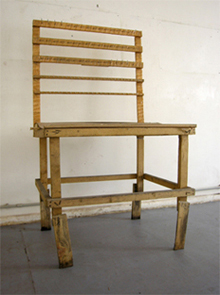
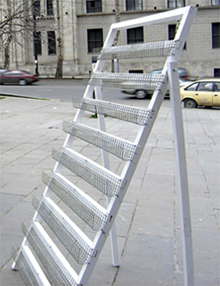

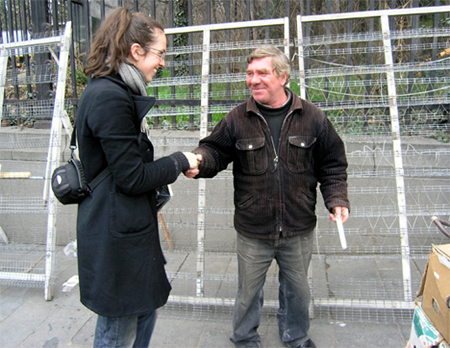
During my stay in Tbilisi I conducted research on the transition of the street kiosk and the way people developed and fabricated displays to sell their goods on the street. The inventive and autonomous way of constructing the displays is part of the economic history of Georgia. There is an evolution of the displays from one piece of paper, a stick, a small table, self designed and developed inventive constructions into a standardized Coca-Cola kiosk. When the economy and regulations for selling goods are developing at the current speed, all the improvised and handmade displays will disappear out of the city within the next years. I decided to collect and preserve some examples of displays. Besides the sculptural quality of the objects, the displays might help in the future to understand how Georgia’s rebuilding has developed and where it all began. Like in most democracies, it literary started with a piece of paper and a stick…
After I visualized the evolution of the display in a series of drawing and photographs I decided to make a collection of the authentic displays. I encountered people with interesting and special displays to question whether it was possible to make a exact copy of their display if they would like to exchange their display for my copy. The exchange itself is an important moment in the process. The two exchanged displays and satisfied owners reveal bits about the complicated situation between the West and the rebuilding of Georgia at that moment. The owners from Tbilisi were amazed by the new standardized copy, and I from the Netherlands who’s totally fascinated by the character and authenticity of the old ones. There is a strong longing for the ‘West’ in Georgia and ‘the West’ is curious and fascinated by the Eastern countries. This exchange of ideologies and the aims of the rebuilding Georgia was an important point for discussion. These exchanged displays and a series of photographs of the actual exchange resulted in a presentation of ‘The revolution is just around the corner’.
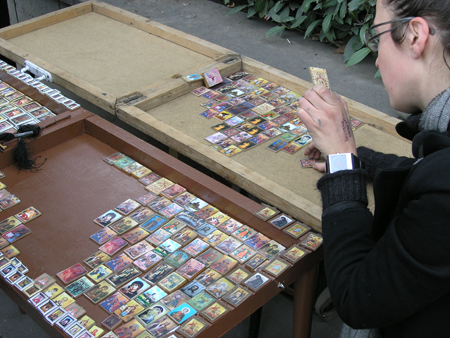
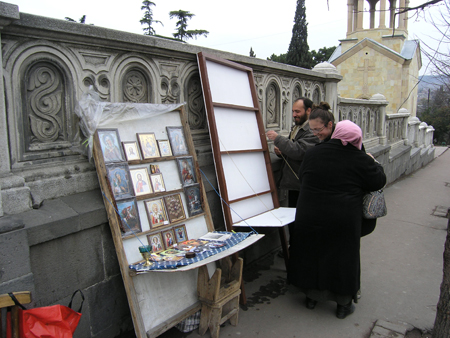
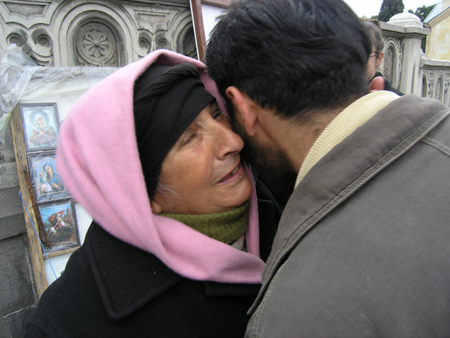
Preservation of the Future II
april 6th, 2006After the Independence of Georgia in 1991, many things have changed. The Lari, for instance, became the new currency in 1993. The western economy was introduced and brought many new products, which made others disappear. To ensure the remembrance of this period in Georgian history, some artifacts representing Georgia at the present moment were collected and put in the ground, for future archaeologists to discover.

In October 2006, in the frame-work of Art Caucasus, many more object will be preserved for the future and put in the ground of the Ethnographic Museum in Tbilisi. Reversing the vision on any science towards the future is of major importance in Georgia and the rest of the world. The new generation should know about the project to tell their children, so they can tell their children, and so on… so the modern history of Georgia is preserved for future generations.
Maarten Vanden Eynde
Preservation of the Future, 2006
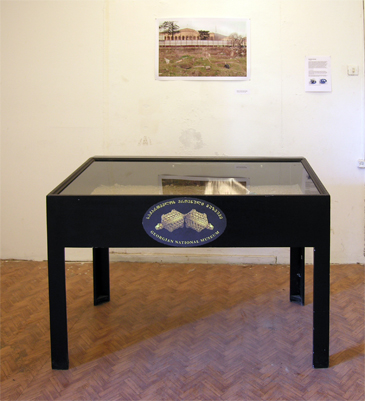
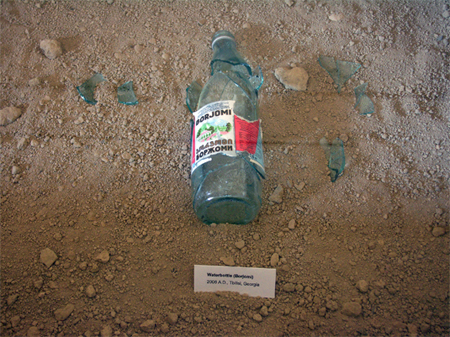
On Wednesday the 15th of March 2006 a set of Lari coins (50, 20, 10 and 5 tetri) were buried in the garden of the NAC/National Art Center in Tbilisi, Georgia, right in front of the Parliament.
Preservation of Georgian Lari, 2006
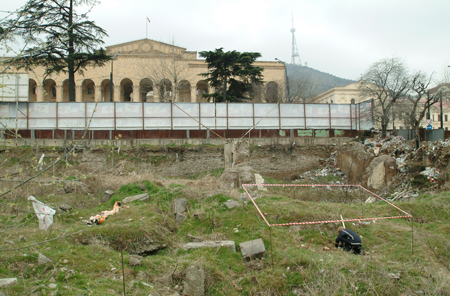
Preservation of the Future
maart 10th, 2006Preserving information and ensuring the transmission of knowledge from one generation to another is an ancient cultural activity. As a field within library and archival science, preservation is only a few decades old. It began primarily as item-level repair and conservation, deriving its original professional traditions and physical techniques in large part from the museum world. To the importance in that world of the repair and conservation of individual pieces deemed to be of special value as artifacts, preservation in libraries has added the significance of the archival value of the object as bearer of historical evidence. In a very short time, preservation has developed into a critically important part of managing library’s and museums most precious assets, its collection. Paradoxically, dedicated as it is to mitigating the deleterious effects of aging, preservation has rapidly become, along with computer applications, one of the most forward-looking fields in the library and archival profession. One step further is the predetermined preservation of all possible things representing the present. What do we preserve for the future?
Based on a text by Abby Smith.
Biosphere II in Arizona (funded by billionaire Ed Bass)
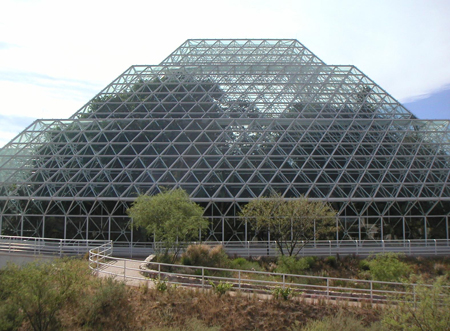
Biosphere 2 is a 3.15-acre (12,700 m2) structure originally built to be an artificial closed ecological system in Oracle, Arizona (USA). Constructed between 1987 and 1991, it was used to explore the complex web of interactions within life systems. It also explored the possible use of closed biospheres in space colonization, and allowed the study and manipulation of a biosphere without harming Earth’s. The name comes from the idea that it is modeled on the first biosphere, which is the life system on Earth. The first closed mission lasted from September 26, 1991 to September 26, 1993. The crew were: medical doctor and researcher Roy Walford, Jane Poynter, Taber MacCallum, Mark Nelson, Sally Silverstone, Abigail Alling (a late replacement for Silke Schneider), Mark Van Thillo and Linda Leigh. At a size comparable to two and a half football fields, it was the largest closed system ever created. The sealed nature of the structure allowed scientists to monitor the ever-changing chemistry of the air, water and soil contained within. The health of the human crew was continuously monitored by a medical team. After several month extra oxygen was needed from the outside world. Several animal species died and food was scarce. No mission was ever succesfull in the sense that Biosphere II proved to be a functional alternative to Biosphere I.
Mark Dion
Mobile Wilderness Unit, 2001 (290 x 170 x 380 cm)
Damien Hirst
Away from the Flock, 1994
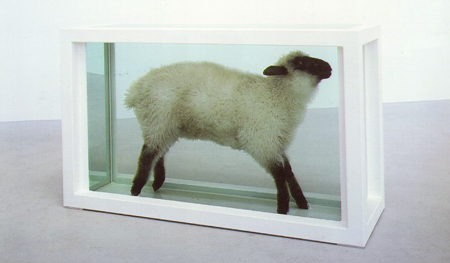
Modern Archaeology II
maart 9th, 2006Maarten Vanden Eynde
Genetologic Research nr.22; 60937 Ikea-era, 2005 A.D., Rome, Italy
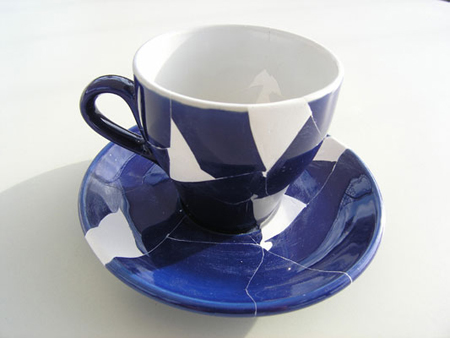
Genetologic Research nr.23; 50075026 Ikea-era, 2005 A.D., Rome, Italy
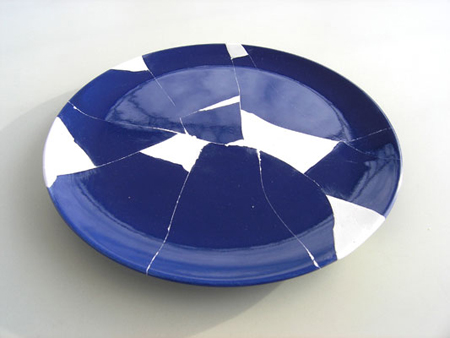
Ichthyosaurus
maart 8th, 2006Mark Dion
Ichthyosaurus, 2003
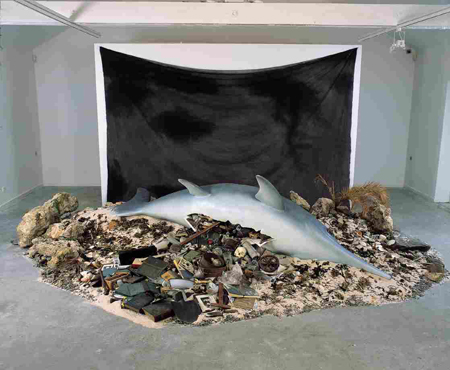
(pronounced IK-thee-oh-SAWR-us) Ichthyosaurus was an ichthyosaur, a marine reptile; it was not a dinosaur. This sleek animal could perhaps swim at speeds up to 25 mph (40 kph). Ichthyosaurus lived from the early Jurassic period until the early Cretaceous period, roughly 206 to 140 million years ago.
Anatomy: Ichthyosaurus was about 6.5 feet (2 m) long and ay have weighed about 200 pounds (90 kg). It had a tall dorsal fin, a half-moon-shaped tail, paddle-like flippers, and smooth skin. The nostrils were near the eyes on the top of the head. It had massive ear bones and large eyes, probably indicating that it had acute hearing and keen eyesight. These marine reptiles gave birth to live young.
Diet: Ichthyosaurus’ diet was mostly fish, but may have also included cephalopods (like straight-shelled belemnites).
Fossils: Hundreds of Ichthyosaurus fossils have been found in England, Germany, Greenland, and Alberta, Canada. Even fossilized dung (called coprolites) and fossilized skin impressions have been found. Ichthyosaurus, which means “fish lizard,” was named by Charles Koenig in 1818.
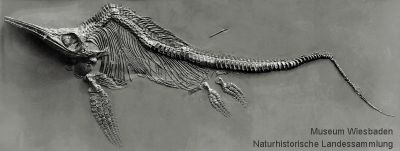
Extraterrestrial Art
februari 27th, 2006On the 2nd of June 2003 an artpiece was send to another planet for the first time in human history. The painting, by Damien Hirst, consists of 16 multi-coloured spots on a 5cm by 5cm aluminium plate which was bolted to the lander, which was send to Mars . It had to cope with the cold of Mars, where temperatures drop to minus 70C, and pre-launch sterilisation which heats the painting to 155C.
Every part was designed to be useful. The aluminium plate was used to calibrate Beagle 2’s X-ray, the colours will check the camera, and minerals in the pigments would correct the sensor measuring the soil’s iron content. Beagle 2, named after the famous exploration-ship of Darwin, was launched on board the European Space Agency Mars Express craft from Kazakhstan.
Before Mars Express enters the orbit of Mars, Beagle 2 will be jettisoned and bounce to the planet’s surface, cushioned by inflatable bags. It will analyse sub-surface soil and rocks and take samples of the atmosphere to find out if life ever existed there.
Prof Pillinger, who commisioned Hirst said: “This collaboration is not about displaying art in space but about finding out if there is life on Mars.”
Just a few inches across and resembling a child’s watercolour paint box, the trademark Hirst spot painting was bolted to the British Beagle 2 space probe after a preview at London’s White Cube gallery.
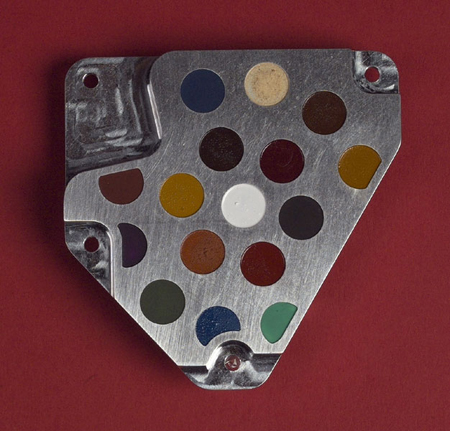
The pop group Blur also has a Beagle 2 connection. They wrote the call sign which the probe would send to mission control when it landed on Mars. (listen to the song on BBC website)
Beagle 2 was last seen heading for the red planet after separating from its European Space Agency mothership Mars Express on December 19 2003. Part of a mission estimated to cost $85 million, the probe was supposed to land on Mars a few days later on Christmas Day and search for signs of life, but vanished without trace…
SETI, the Search for Extraterrestrial Intelligence, is an exploratory science that seeks evidence of life in the universe by looking for some signature of its technology. (http://www.seti.org)
The Science of Freedom
februari 26th, 2006Joseph Beuys (1921-1985)-“sculptor, painter, draftsman, graphic designer, action artist, art theorist, politician, and poet”-decided to devote himself to art during World War II. Earlier, he thought he wanted to be a doctor, but just prior to enlisting he had spent a year as an acrobat in the circus so nothing was certain….
Beuys had been fascinated since childhood by the natural sciences, and thought that medicine would offer a way to integrate his interest in science with his urge to bring about healing. He would actually spend his life doing these very things, but art, not medicine, would be his vehicle.
In the 1970s Beuys created the Theory of Social Sculpture:
“My objects are to be seen as stimulants for the transformation of the idea of sculpture. . . or of art in general. They should provoke thoughts about what sculpture can be and how the concept of sculpting can be extended to the invisible materials used by everyone.
THINKING FORMS–how we mold our thoughts or
SPOKEN FORMS–how we shape our thoughts into words or
SOCIAL SCULPTURE–how we mold and shape the world in which we live:
SCULPTURE AS AN EVOLUTIONARY PROCESS; EVERYONE IS AN ARTIST.
That is why the nature of my sculpture is not fixed and finished, processes continue in most of them: chemical reactions, fermentations, color changes, decay, drying up. Everything is in a state of change.”
To Beuys, ‘Social Sculpture’ based upon interactive dialogue had the potential to be transformative and healing. In the action ‘ I Like America And America Likes Me’, Beuys shared living quarters with a live coyote for five days in the Rene Block Gallery in New York.
He often used animals to teach the lessons of social ecology -“the cultural characteristics and patterns of social organisation that have brought about the current ecological crisis” -and ecofeminism- how the domination of man over the natural world reproduces his domination in society, leading to mutually catastrophic destruction.
I Like America And America Likes Me, 1974
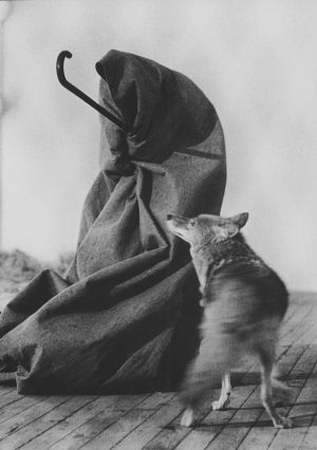
“To make people free is the aim of art, therefore art for me is the science of freedom.” Joseph Beuys
Japanese Golfball Eggs
februari 25th, 2006Oology is the branch of zoology that deals with the study of eggs, especially birds’ eggs. It can also be applied to the hobby of collecting wild birds’ eggs (which is now illegal in many jurisdictions). Oology includes the study of the breeding habits of birds, and the study of their nests. (The study of birds’ nests is sometimes called caliology).
Birds’ eggs are conveniently classified as marked or unmarked, according to the ground color. Birds which lay their eggs in holes in trees or in the ground almost always have white, unspotted eggs. Birds which build in trees generally have blue or greenish eggs, either spotted or unspotted, while birds that build in bushes, near the ground, are likely to lay speckled eggs.
Guillaume Bijl
‘Sorry’, 1987 (15cm x 8cm x 15cm)
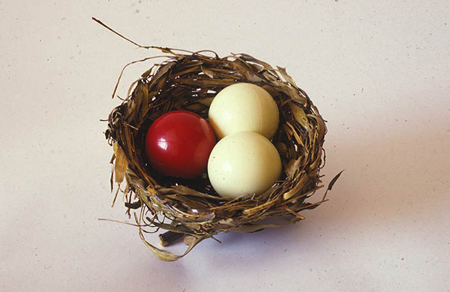
Maarten Vanden Eynde
Genetologic Research Nr. 17, 2004 (16cm x 20cm x 16cm)
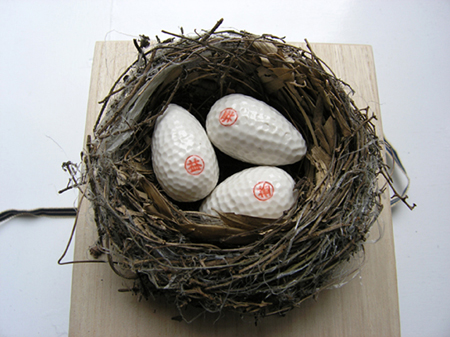
The Three Body Problem
februari 19th, 2006The Three Body Problem is the mathematical problem of finding the positions and velocities of three massive bodies, which are interacting each other gravitationally, at any point in the future or the past, given their present positions, masses, and velocities. An example would be to completely solve the behavior of the Sun-Jupiter-Saturn system, or that of three mutually orbiting stars. It is a vastly more difficult exercise than the two-body problem. In fact, as Henri Poincaré (1854-1912) and others showed, the three-body problem is impossible to solve in the general case; that is, given three bodies in a random configuration, the resulting motion nearly always turns out to be chaotic: no one can predict precisely what paths those bodies would follow.
Watch here: The Tree Body Problem animation
Genetologic Research Nr. 6, 2003 (300cm x 300cm x 300cm)
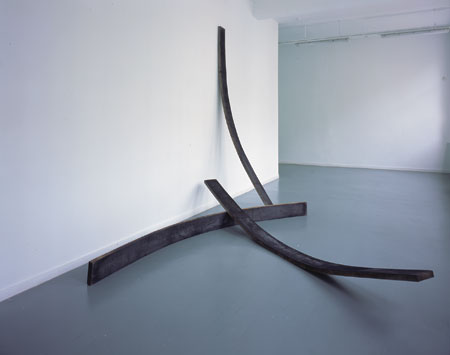
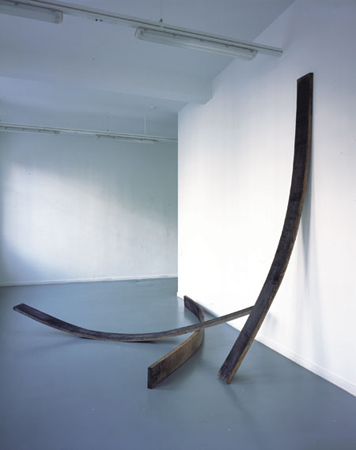
Maarten Vanden Eynde
Three wooden (oak) beams are manually bended by fire and water during a three week lasting ’torture-session’. After being liberated from the bending-machine, the beams stay in their forced position. The thee bodies are photographed in a certain way, but can change position without loosing their inter-relating balance. Various positions have been tried and just a few points of view bring them into a harmonious equilibrium. Any change or random elaboration creates chaos or disharmony.
Chaos Theory
februari 7th, 2006According to classical Greek myth, only Chaos existed in the beginning.
Chaos theory refers to the behavior of certain systems of motion, such as the atmosphere, the solar system, plate tectonics, ocean currents, economies or population growth, to be especially sensitive to tiny changes in starting conditions that result in drastically different outcomes. The biggest weather computer in the world, in the European centre for Medium-range Weather Forecasting, does as many as 400 million calculations every second. It is fed 100 million separate weather measurements from around the world every day, and it processes data in three hours of continuous running, to produce a ten day forecast. Yet beyond two or three days the forecasts are speculative, and beyond six or seven they are worthless. Chaos theory, then, sets definite limits to the predictability of complex non-linear systems.
Unlike what it implies colloquially, chaos theory doesn’t mean the world is metaphorically chaotic, nor does it refer to entropy, by which systems naturally tend toward disorder. Chaos theory relies on the uncertainty inherent in measurements, the precision of predictions, and the non-linear behavior of seemingly linear systems.
Chaos theory came on the scientific scene in the late 1970s. It was introduced by a self-motivated group of Santa Cruz scientists. As students they had to fight their faculty to pursue their fascination with this unorthodox subject. After its initial presentation, chaos became a buzzword in many disciplines, as scientists thought of ways it applied in their fields. Even more interesting, scientists began crossing over fields, developing multidisciplinary approaches.
Chaos is not entirely random, but is an occult, “hidden,” or implicate order within nature. Cosmology, weather prediction, animal migration patterns, quantum mechanics, and more were affected. We now have terms like “quantum chaos,” and chaotic planetary motion. Chaos is a major influence from the microcosm to the macrocosm.
Creation came out of chaos, is surrounded by chaos and will end in chaos.
–Anonymous
Maarten Vanden Eynde
Genetologic Research Nr. 10, 2004 (back: 100cm x 100cm x 150cm – front: 40cm 70cm)
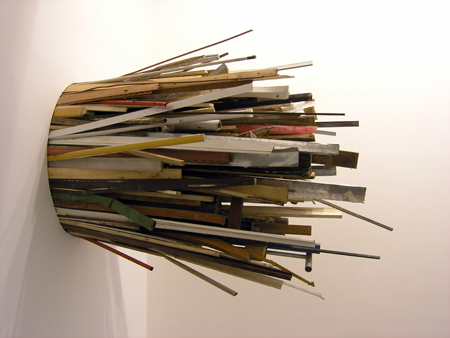
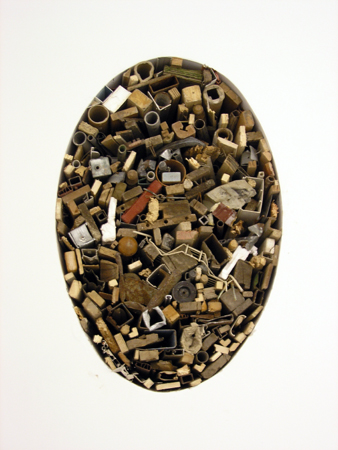
The work consists of found materials (wood-, plastic-, metal), gathered together during one month from the streets of Naples, Italy. Al the scrap is pressed into an oval hole of a 40 cm thick wall. The front side shows a flat, orderly ‘abstract’ image. The back is exploding of energy, being sucked in or puked out. The tension was so high that the wall started to crack. The seemingly quiet, almost sacral image of the front side (which is faced towards the inside space) originates from but is contradictory to the chaotic and violent back side (which is faced to the outside streets of the turbulent city life of Naples).
Big Bang Theory
februari 4th, 2006The Big Bang Theory is the dominant scientific theory about the origin of the universe. According to the big bang, the universe was created sometime between 10 billion and 20 billion years ago from a cosmic explosion that hurled matter in all directions.
In 1927, the Belgian mathematician and Catholic priest Georges Lemaitre was the first to propose that the universe began with the explosion of a primeval atom. His proposal came after observing the red shift in distant nebulas by astronomers to a model of the universe based on relativity. Years later, Edwin Hubble found experimental evidence to help justify Lemaitre’s theory. He found that distant galaxies in every direction are going away from us with speeds proportional to their distance.
In January 1933, Lemaitre traveled with Albert Einstein to California for a series of seminars. After the Belgian detailed his Big Bang theory, Einstein stood up, applauded, and said, “This is the most beautiful and satisfactory explanation of creation to which I have ever listened.” Lemaitre’s theory, the idea that there was a burst of fireworks which marked the beginning of time and space on “a day without yesterday”, was a radical departure from prevailing scientific understandings, though it has since come to be the most probable explanation for the origin of the universe.
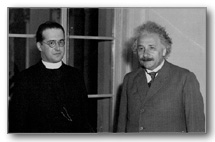
The big bang was initially suggested because it explains why distant galaxies are traveling away from us at great speeds. The theory also predicts the existence of cosmic background radiation (the glow left over from the explosion itself). The Big Bang Theory received its strongest confirmation when this radiation was discovered in 1964 by Arno Penzias and Robert Wilson, who later won the Nobel Prize for this discovery.
Although the Big Bang Theory is widely accepted, it probably will never be proved; consequentially, leaving a number of tough, unanswered questions.
Pre- Genetologic Research, 2000 (400cm x 400cm x 400cm)
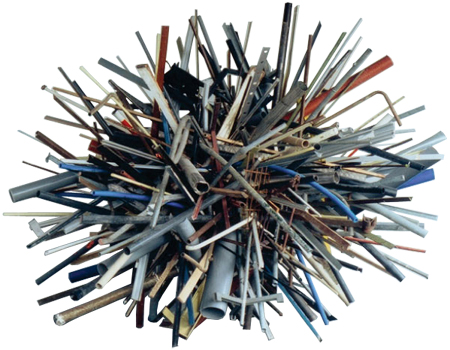
Maarten Vanden Eynde
This work was made without any glue, welding, binding or screwing. All pieces are forces in a small square core. The tension is holding everything together. It creates an implosion as well as an explosion. But by having equal forces, the whole thing freezes and comes to a stand. It is representing the end as much as the beginning.
